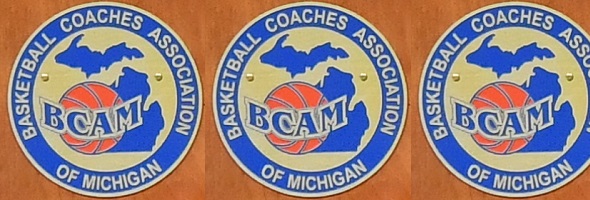
Final 'Retro' Mr Basketball Class Named
April 12, 2019
Special from Basketball Coaches Association of Michigan
With the completion of the 2018-19 prep basketball season, the Basketball Coaches Association of Michigan proudly wraps up its decade-long “Retro” Mr. Basketball project with the announcement of the final six honorees.
Over the course of 10 seasons, the project has examined the high school court careers of hundreds of the state’s finest. The list of 61 honorees, when combined with the winners of the current ‘Mr. Basketball’ Award, first presented following the 1980-81 prep season, totals 100. A contiguous list of Michigan’s ‘Best of the Best’ now dates back to 1920.
Noting the amazing pool of talented basketball players produced by the state over the years, past Basketball Coaches Association of Michigan Executive Director Tom Hursey and Michigan High School Athletic Association historian Ron Pesch hatched a plan to replicate the ‘Mr. Basketball’ concept, and apply it to the past. The goal was to name the top high school senior ballplayer for each of the 61 years between 1920 and 1980.
To do so, Pesch hit the archives, examined the data, gathered names and assembled biographies, then provided a ballot. BCAM assembled a committee representing all parts of Michigan to examine the information, narrow the field to the best-of-the-best, and then vote for a winner.
“All along, the idea was to focus solely on the high school playing careers of these individuals, just like the current award,” said Hursey. “The committee did its best to ignore what came later, and to name a Mr. Basketball selection for each year. Now, with the 10th and final round of selections, the project is complete.”
“Just like with the current award, there will always be debate on the selections,” said Pesch. “Dave DeBusschere or Chet Walker? L.C. Bowen or Richie Jordan? Bill Chmielewski or Pete Gent? That’s a good thing. These players should never be forgotten in the halls of their high schools and by basketball fans across the nation. Michigan has produced and continues to turn out amazing athletic talent, year in and year out. So often, folks only recall the recent past. The ‘Retro’ Mr. Basketball project focuses a spotlight on our history.”
That spotlight now shines on the award that captures the names. Following the 2013 presentation of the award, BCAM retired the original Mr. Basketball trophy. The award has since been repurposed to capture the names of the “Retro” Mr. Basketball winners. The trophy now stands on display in East Lansing as part of the Tom Izzo Hall of History at the Breslin Center.
1929 RETRO MR. BASKETBALL
LOUIS JAGNOW, JACKSON –
1929 FINALISTS
Forest Baldwin, Bridgman – Captain of the Class D champion. Although not of unusual size, Baldwin was considered as lightning fast and a deceptive dribbler with an uncanny shot. He scored 22 points in the team’s Quarterfinal victory over Grand Rapids Godwin.
Neil Ludwick, Grand Rapids Creston – Center and top player on the best Creston team to date. Despite a Quarterfinal loss in the Class A tournament, Ludwick was singled out and named to the all-tourney team in 1929. A mid-year graduate in 1930.
Lester Wamsley, Highland Park – A steady, smart cager, Wamsley was an All-City selection by both the Detroit Times and Detroit Free Press, and a United Press International All-Tournament selection. Praised as an outstanding guard, good on long shots.
1939 RETRO MR. BASKETBALL
GENE BROENE, GRAND RAPIDS CHRISTIAN
1939 FINALISTS
Chet Jurwiak, Kalamazoo St. Augustine – “The state’s standout high school basketball player under the basket. He invariably grabbed 80 percent of the balls off the back board during a game,” wrote the Detroit Times when selecting him for first-team all-state honors. “Jurwiak was all-state in football and lost none of his ability on the court.”
Earl Kelly, Flint Northern, 6-foot-3 – described by a veteran Saginaw Valley Conference official as the best player in the league. Scored 176 points in 20 games in leading Northern to its third Class A championship in the school’s 11-year history. A mid-year graduate in 1939-40.
Ed (Nowaczyk) Novak, Flint St. Mary – First team all-state according to both the Free Press and the Times. Scored 260 points as a senior and, with his twin brother Edwin, “helped St. Mary annex the Class C state crown. Through his height he controlled the ball off both backboards, besides tossing in baskets on a highly productive basis.”
Frank Sabo, Detroit Southwestern – “Sabo was considered by many coaches as the best passer in the (Detroit city) league,” said the Free Press. “An outstanding floorman,” added the Detroit Times when naming Sabo to its all-city team. “Superlative off the backboard, a good shot and, above all, a fine leader.” Later played at Wayne University.
1949 RETRO MR. BASKETBALL
KEN BURRELL, HAMTRAMCK, 6-FOOT-3, 182
1949 FINALISTS
Chuck Holloway, Detroit Northern, 5-foot-8 – “He’s an all-around star, outstanding in the clutch as exemplified in the (City League playoff) semifinal game against Central, where he led Northern in a rally to win. He topped the loop in scoring (14 point average), is fast and difficult to stop,” wrote the Times. “Despite his lack of height, was probably the most adept player in the (Detroit City) league. An uncanny shot, he led Northern into the finals of the (league) playoffs,” wrote the Free Press.
Harry Lauder, Ferndale, 5-foot-11, 155 – Spectacular scorer and all-around performer and the spark of his team. “Was ‘raved over’ by virtually everyone who saw him perform,” stated the Times, when selecting him for first-team all-state honors. Called by his coach, Roy Burkhart, “one of the smoothest all-around players I’ve ever seen. The kid also is loaded with basketball sense.” Later played freshman and varsity basketball at Michigan.
Lysle Smith, Port Huron, 5-foot-11, 155 – “Known as a ‘pressure’ player who also draws the evening’s toughest defensive assignment for his team. His 193 points this season were mostly on set shots from far out on the court,” wrote the Free Press, honoring Smith with first-team all-state accolades. Later played at Michigan, where he became the first cager from Port Huron to win a varsity letter.
Carl Tschirhart, Milan, 6-foot-0, 155 – An all-around athlete and key cog in Milan’s 1948 Class C title, Tschirhart “connected on 33 percent of his 288 shots from the floor” as Milan ran its win streak to 40 games straight, spanning two seasons, before falling in the Regionals of the 1949 tournament. Later played for Michigan Normal (now Eastern Michigan University).
1959 RETRO MR. BASKETBALL
DAVID GAINES, DETROIT NORTHEASTERN, 6-FOOT-0, 180
1959 FINALISTS
John Bandy, Pontiac Central, 6-foot-3, 160 – A jump shooting specialist. “Averaged 19 points a game during the regular season to take the individual scoring title in the strong Saginaw Valley League,” said the Detroit Times, including him on its Dream Team. “Was Pontiac’s second leading rebounder,” wrote the Free Press when naming him Class A first-team all-state. “He could score from any spot on the floor.” Played college ball at Western Michigan University.
Jim Ludwig, Sault Ste. Marie, 6-foot-5½, 185 – “Rewrote virtually all of Sault Ste. Marie High’s individual scoring records,” wrote George Maskin in the Times. “A four-year veteran on the Blue Devils, he tossed in more than 1,100 points … During the recent season he collected over 450 points (373 in regular season play) and had a superlative shooting mark of 46 percent. Jim also headed the Soo in rebounds.”
Art Oliver, Muskegon Heights, 6-foot-0, 162 – Clever, sharpshooting guard. Leading scorer for the Tigers, totaling 318 points over 18 games, and 21.5 points per game over the last half of the season before the Heights fell to Grand Rapids Central in Regional play. A first-team all-state selection by both the Free Press and Times.
Art Reid, Hamtramck, 6-foot-2, 186 – “A superior rebounder and jumper, (and tireless worker), averaged 22 points a game for Hamtramck,” said Hal Schram in the Free Press. “Deadly from the corners as well as in front of the basket,” added the Times. He scored 364 points including 44 of 67 from the free throw line.
Jim Tilmon, Grand Rapids Central, 5-foot-9, 170 – “’Tilmon is the best around here since Don Eaddy,” chronicled Eugene Gailmeier of the Grand Rapids Herald. “Although basically a guard, Tilmon rotated so swiftly from one position to another it was impossible to tell at times what job he actually held,” said the Times. Led the city league in scoring. His 27 points in the Regional Final snapped Muskegon Heights’ string of 17 tournament wins and helped place Central in the Quarterfinals for only the third time in postseason history.
1969 RETRO MR. BASKETBALL
ERNIE JOHNSON, GRAND RAPIDS OTTAWA HILLS, 6-FOOT-7, 190
1969 FINALISTS
Ken Brady, Flint Central, 6-foot-9, 220 – Best big man to come out of Flint in many years. “Despite his 220 pounds, Brady gets up and down a basketball court with the agility and speed of a dashman. (Coach Clif) Turner insists he is often more valuable for his defensive play than his point production,” said Hal Schram in a midseason article. Set a new city scoring mark with 521 points in 21 games while helping Central win the Valley conference title. United Press International ‘Player of the Year’ in Michigan.
Tom Marsh, Detroit Northern, 6-foot-1, 168 – “Possibly the best player in either the Detroit Catholic or public school league” said The Associated Press, Marsh “became Northern’s first player to top 1,000 points in three varsity seasons. He averaged 27 points a game and was a fine outside shooter.”
Tim Megge, Orchard Lake St. Mary, 6-foot-2, 175 – Averaged 25.4 points a game, including a school record 56 points in one game, preceded by a 51-point game. Hit 46 percent of his field goal attempts and 72 percent of his foul shots according to UPI. In 81 games during his four-year varsity career, Megge scored 1,612 points.
Bob Rhodin, Ypsilanti – 6-foot-3½, 170 – “Led Ypsilanti to a 22-1 record and a No. 1 rating in the final AP poll. Scored 360 points during the year for a 19 point average and was the team’s top rebounder, grabbing 227,” said the AP. “Coach Dick Ouellette calls him ‘the best all-around player I’ve ever had.’ Rhodin has tremendous hustle and is a great defensive ballplayer.”
Cal Tatum Muskegon, 6-foot-1, 170 – "For his size, I've never seen an athlete who is so proficient in so many phases of the game," said then-Muskegon coach Mike Murphy. A guard, Tatum averaged 22.4 points, 10 rebounds, five assists and four steals per game his senior year to earn first-team all-state honors. He graduated as the Big Reds' all-time leading scorer with 1,250 career points, and an average of 22.7 points per game as a senior.
1979 RETRO MR. BASKETBALL
JAY SMITH, MIO AuSABLE, 6-FOOT-5, 192
1979 FINALISTS
Tim Andree, Birmingham Brother Rice, 6-foot-10, 230 – The “best big man in the state,” wrote Hal Schram in the Free Press. Averaged 23 points and 17 rebounds per game.
James Koger, Saginaw, 6-foot-4, 190 – A 1,000-plus career scorer who averaged 19.7 points, 11 rebounds and shot 47 percent from the floor” said the AP. “He ran the Saginaw offense,” added the Free Press in its first-team all-state write-up. “When he wasn’t in the lineup, Saginaw was a very ordinary team.”
Melvin McLaughlin, Grand Rapids Creston, 6-foot-1, 170 – Considered the state’s top “pure shooter,” McLaughlin scored 1,577 points, a 25.4 average, in his three-year career at Creston. Exceeded the 35-point mark in a game on four occasions as a senior.
Evaristo Perez, Orchard Lake St. Mary, 6-foot-8, 210 – Despite being in the U.S. less than two years, the Dominican Republic native averaged 22 points and 15 rebounds while hitting 57 percent of his shots. “He’s a real competitor and a leader on the flow,” St. Mary coach Bob Shoemaker told the Free Press. “We do a lot of things on the court, and he picked them up right away.”
Derek Perry, River Rouge, 6-foot-6, 210 – Coach Lofton Greene told Hal Schram that Perry was “probably the finest offensive player he has ever coached.” Averaged more than 28 points per game and “an incredible field-goal shooting percentage of 64 percent” entering the postseason.
Erich Santifer, Ann Arbor Huron, 6-foot-5, 165. “He has been the most valuable player in the rugged South Central Conference two years in a row,” said the Lansing State Journal at tournament time. “He prefers to work inside, but can also produce from long range as well.” Santifer held a 22.3 points per game average headed into the tournament Regional Final against Lansing Eastern, then scored 36 points against the Quakers in the contest although Huron was eliminated. “He’s probably the finest player we saw all season,” said Lansing Eastern coach Paul Cook. Later excelled at Syracuse.
MICHIGAN’S MR. BASKETBALL AWARD
Players from 1981-Present were honored as part of the current BCAM/Detroit Free Press Hal Schram Mr. Basketball Award. Players from 1920-1980 were selected as part of BCAM’s decade-long “Retro” Mr. Basketball project, launched in 2010 and completed in 2019.
2019 Romeo Weems, New Haven (DePaul)
2018 Foster Loyer, Clarkston (Michigan State)
2017 Isaiah Livers, Kalamazoo Central (Michigan)
2016 Cassius Winston, University of Detroit Jesuit (Michigan State)
2015 Deyonta Davis, Muskegon (Michigan State)
2014 DeShawn Thrower, Muskegon (Stony Brook/Ferris State)
2013 Monte Morris, Flint Beecher (Iowa State)
2012 Matt Costello, Bay City Western (Michigan State)
2011 Dwaun Anderson, Suttons Bay (Wagner)
2010 Keith Appling, Detroit Pershing (Michigan State)
2009 Derrick Nix, Detroit Pershing (Michigan State)
2008 Brad Redford, Frankenmuth (Xavier)
2007 Corperryale Harris, Detroit Redford (Michigan)
2006 David Kool, Grand Rapids South Christian (Western Michigan)
2005 Wilson Chandler, Benton Harbor (DePaul)
2004 Drew Neitzel, Wyoming Park (Michigan State)
2003 Dion Harris, Detroit Redford (Michigan)
2002 Paul Davis, Rochester (Michigan State)
2001 Kelvin Torbert, Flint Northwestern (Michigan State)
2000 Marcus Taylor, Lansing Waverly (Michigan State)
1999 Jason Richardson, Saginaw Arthur Hill (Michigan State)
1998 Dane Fife, Clarkston (Indiana)
1997 Shane Battier, Detroit Country Day (Duke)
1996 Winfred Walton, Detroit Pershing (Fresno State)
1995 Robert Traylor, Detroit Murray-Wright (Michigan)
1994 Willie Mitchell, Detroit Pershing (Michigan/UAB)
1993 Jon Garavaglia, Southgate Aquinas (Michigan State)
1992 Kenyon Murray, Battle Creek Central (Iowa)
1991 Chris Webber, Detroit Country Day (Michigan)
1990 Anthony Miller, Benton Harbor (Michigan State)
1989 Michael Talley, Detroit Cooley (Michigan)
1988 Matt Steigenga, Grand Rapids South Christian (Michigan State)
1987 Mark Macon, Saginaw Buena Vista (Temple)
1986 Terry Mills, Romulus (Michigan)
1985 Glen Rice, Flint Northwestern (Michigan)
1984 Demetreus Gore, Detroit Chadsey (Pittsburgh)
1983 Antoine Joubert, Detroit Southwestern (Michigan)
1982 Robert Henderson, Lansing Eastern (Michigan)
1981 Sam Vincent, Lansing Eastern (Michigan State)
1980 Tim McCormick, Clarkston (Michigan)
1979 Jay Smith, Mio-AuSable (Bowling Green/Saginaw Valley)
1978 Trent Tucker, Flint Northwestern (Minnesota)
1977 Earvin “Magic” Johnson, Lansing Everett (Michigan State)
1976 Stuart House, Detroit Denby (Washington State)
1975 Bruce Flowers, Berkley (Notre Dame)
1974 Tony Smith, Saginaw (Nevada-Las Vegas)
1973 Tom LaGarde, Detroit Catholic Central (North Carolina)
1972 Larry Fogle, Detroit Cooley (Southern Louisiana/Canisius)
1971 Michael "Campy" Russell, Pontiac Central (Michigan)
1970 Rick Drewitz, Garden City West (Kentucky)
1969 Ernie Johnson, Grand Rapids Ottawa Hills (Michigan)
1968 Ralph Simpson, Detroit Pershing (Michigan State)
1967 Spencer Haywood, Detroit Pershing (University of Detroit)
1966 Rudy Tomjanovich, Hamtramck (Michigan)
1965 L.C. Bowen, Benton Harbor (Bradley)
1964 Willie Betts, River Rouge (Bradley)
1963 Craig Dill, Saginaw Arthur Hill (Michigan)
1962 Ernie Thompson, Saginaw (Bradley)
1961 Reggie Harding, Detroit Eastern
1960 Peter Gent, Bangor (Michigan State)
1959 David Gaines, Detroit Northeastern (LeMoyne, now LeMoyne-Owens)
1958 Chet Walker, Benton Harbor (Bradley)
1957 Ed Burton (Michigan State)
1956 Mel Peterson, Stephenson (Wheaton)
1955 M.C. Burton, Jr., Muskegon Heights (Michigan)
1954 Pete Tillotson, Ludington (Michigan)
1953 Ron Kramer, East Detroit (Michigan)
1952 Frank Tanana, Sr., Detroit St. Andrew, (Cal State-Fullerton – baseball)
1951 Webster Kirksey, Saginaw (Eastern Michigan)
1950 Charlie Primas, Detroit Miller (Wayne State)
1949 Ken Burrell, Hamtramck (Lawrence Tech)
1948 Art McColgan, Saginaw SS Peter & Paul (Villanova)
1947 Sammy Gee, Detroit Miller
1946 Jack Forestieri, Benton Harbor (Notre Dame)
1945 Bob Swanson, Lansing Sexton (Michigan)
1944 Dick Rifenburg, Saginaw Arthur Hill (Michigan)
1943 Don Boven, Kalamazoo Central (Western Michigan)
1942 Larry Savage, Saginaw (Northwestern)
1941 Don Osterman, Detroit St. Theresa (Villanova)
1940 Ralph Gibert, Flint Northern (Michigan)
1939 Gene Broene, Grand Rapids Christian (Calvin College)
1938 John Maartens, Kalamazoo Central
1937 Bob Osterman, Detroit St. Theresa (Notre Dame)
1936 Charles Pink, Detroit Northwestern (Michigan)
1935 John Zwier, Holland Christian
1934 Earl Brown, Jr., Benton Harbor (Notre Dame)
1933 Lincoln Dodson Truss, Flint Northern
1932 Lowell Matteson, Portage
1931 Edward Huttenga, Grand Haven (Western Michigan)
1930 John Tooker, Kalamazoo St. Augustine (Michigan)
1929 Louis Jagnow, Jackson (Carnegie Tech)
1928 Francis Doolittle, Detroit Northwestern
1927 Bill McCall, Muskegon (Dartmouth)
1926 Roger Grove, Sturgis (Michigan State)
1925 Joe Truskowski, Detroit Northeastern (Michigan)
1924 Bennie Oosterbaan, Muskegon (Michigan)
1923 Henry Schrumpf, Niles (Western Michigan)
1922 Royal Cherry, Grand Rapids Union (Michigan)
1921 George Haggarty, Ypsilanti (Michigan)
1920 Harry Kipke, Lansing Central (Michigan)
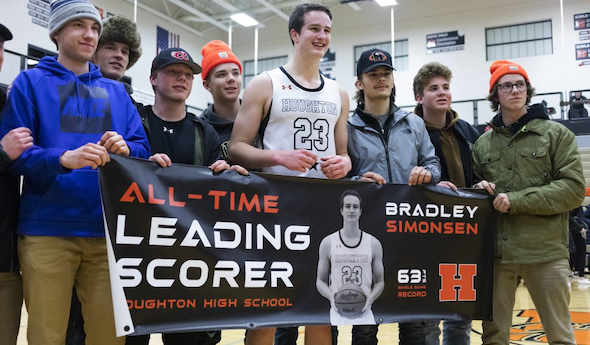
63-Pointer Stirs Memories of UP Legends
February 29, 2020
By Ron Pesch
Special for Second Half
For the first time since 1970 – 50 years ago – and for only the 10th time in Upper Peninsula boys basketball history, a player has scored 60 or more points in a single game.
And that Houghton showing has stoked memories of legendary U.P. scoring showcases going back more than a century.
For the first time, the effort was for naught, at least from a win-loss standpoint, as Houghton dropped a nonconference road contest to Ishpeming 88-83 on Feb. 4. Brad Simonsen hit 23 of 45 field goal attempts, including 7 of 18 from beyond the 3-point arc, as Houghton pushed the play, hoping to narrow what had been a 10-point halftime margin. The 6-foot-6 senior, signed by Michigan Tech, was 10 of 13 from the free throw line and scored 24 points in the fourth quarter, ending the night with 63.
The performance topped Houghton’s school record of 60 points, set by Gary Lange in 1970. The total ranks 14th across the entire state for single game points in a contest, and tied Simonsen for sixth highest above the bridge. There, the mark equaled the top single-game output posted by Stephenson’s Mel Peterson, considered by many the greatest cager ever to come out of the Upper Peninsula.
“Marvelous Mel”
Peterson was the son of a minister and one of 10 children (and eight boys). His older brother, George, broke the U.P. scoring record in 1949 with 44 points in a game for Stephenson High School. The family moved away from the Upper Peninsula following George’s graduation, ultimately landing in southeastern Idaho.
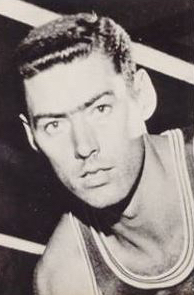 There, Mel emerged as an outstanding athlete for Idaho Falls High School. Standing 6-foot-4½, Peterson’s growth occurred mostly during his freshman year.
There, Mel emerged as an outstanding athlete for Idaho Falls High School. Standing 6-foot-4½, Peterson’s growth occurred mostly during his freshman year.
“I played quite a bit on the varsity my sophomore year,” recalled Peterson recently. “My junior year I started out very, very slow but ended up very good. (However,) I fractured my ankle with about a minute to go in the semifinals of the (1955) state tournament, which we won.”
Peterson led all scorers with 25 points and dominated the boards that night, but had to be helped from the floor, then didn’t play in the title contest. “We lost the state tournament by three points, (43-40 to Kellogg). I was a cheerleader. … It would have been fun to play in the final game.”
When his father received a call to serve the Mission Covenant Church in Wallace, Michigan, about seven miles south of Stephenson, the family returned to the Upper Peninsula for Peterson’s senior year.
“At that time, it was nothing like it is now, where you can find anything about anybody. Then, that wasn’t the case at all,” Peterson said. “So, when we came back, no one had any idea of where I lived before, if I played or not.”
Indeed, prior to football season, one newspaper report indicated Peterson had transferred in from North Dakota, while another listed him as coming from Illinois. Regardless, Peterson emerged as a solid football player at Stephenson High in the fall of 1955. But it was on the basketball court where his scoring and rebounding prowess quickly loomed. He opened the season with 33 points in a win over Gladstone, despite fouling out early in the fourth quarter.
By January, the media had taken to calling him “Marvelous Mel” as Peterson averaged 32.3 points in his first half-dozen games for the Eagles. He drove Stephenson to a 15-1 regular-season record, posting 11 games over 30 points and scoring more than 40 in six.
On Jan. 21, 1956, he poured in 63 points in an 89-44 win over Manistique, shattering his brother’s school record. Mel nailed 25 of 38 shots from the field and 13 of 16 from the free-throw line. At the time, the scoring total exceeded the previous known best in the U.P. of 60 points, scored by Norbert Purol in February 1952. (Purol, from Ironwood St. Ambrose, would later play two seasons of AAU ball in Chicago before matriculating at Kentucky Wesleyan, earning four letters between 1956 and 1959. Wesleyan ended the 1957 season as runner-up to Wheaton College in the inaugural NCAA Small College Tournament – now known as Division II.)
“I don’t remember a great deal about a lot of it. That was so long ago,” said Peterson, laughing. “I guess the thing I appreciate most about the game was that my coach (Duane “Gus” Lord), let me play the whole game, which didn’t happen real often. Probably the thing I remember most about the whole year is that we played a Catholic school, Lourdes, from Marinette, Wisconsin. The first game we played them we beat them 110 to 44. The second game we lost 68-66.”
Peterson’s regular-season total of 570 points also exceeded Purol’s U.P. record of 556 posted over 19 games in 1952. His regular-season average, which had climbed to 35.6, topped the previous best of 29.6, posted by Pete Kutches in 1952 for Escanaba St. Joseph. Then Peterson pushed the per-game-average even higher in the postseason.
Seeing more playing time in the playoffs, “Marvelous Mel,” notched more than 30 points in all seven postseason games (exceeding 40 in three of the contests and 50 once), leading Stephenson to the MHSAA Class B championship win against Detroit St. Andrews in sudden-death overtime, 73-71. There he scored the game-tying bucket with 17 seconds remaining in the three-minute extra frame, and then sunk the game winner 26 seconds into sudden death, where the first team to gain a two-point advantage was proclaimed the victor. That 1956 season saw three of the four basketball championships awarded to U.P. teams.
Peterson finished with 849 points on the year – at the time the best single-season performance in MHSAA history. He averaged 36.9 points across 23 contests – currently eighth in the MHSAA record book.
Following graduation, Peterson nearly signed to play at the University of Minnesota, but felt a better fit at Wheaton College, outside Chicago. There, he earned three All-American honors. As a freshman in 1957, he led Wheaton to victory in that first NCAA Small College Tournament championship game against Wesleyan, earning Most Outstanding Player honors along the way. Today, he remains Wheaton’s all-time leader in career points, points per game, field goals made and career rebounds, all accomplished “without the benefit of a 3-point line, which had yet to be implemented.”
Peterson, who helped the USA team win gold at the 1963 Pan American Games in Sao Paulo, Brazil, played two games for Baltimore in the National Basketball Association (NBA) before a heart condition sidetracked his career. Once the issue was repaired, he returned to play 134 games over three seasons in the American Basketball Association, earning an ABA league championship with the Oakland Oaks in 1969. In 2019, he was inducted into the Small College Basketball National Hall of Fame.
The High-Scoring Sixties
Roger Roell, a senior at Channing, topped Peterson’s U.P. single game record with a 67-point performance in early January 1960 by dropping 31 field goals and five free throws in a 105-55 win over Michigamme.
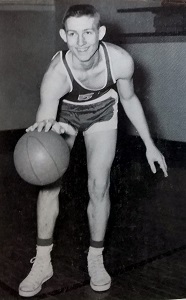 Just over seven weeks later, Jim Manning scored 69 for Trout Creek against Amasa in another lopsided affair, 140-47 (then, a U.P. record for highest team score. The team’s 44 points in the fourth quarter was also a U.P. mark at the time. Trout Creek’s coach, Bruce Warren began substituting in the second quarter).
Just over seven weeks later, Jim Manning scored 69 for Trout Creek against Amasa in another lopsided affair, 140-47 (then, a U.P. record for highest team score. The team’s 44 points in the fourth quarter was also a U.P. mark at the time. Trout Creek’s coach, Bruce Warren began substituting in the second quarter).
Manning, a junior, finished the 1959-60 season as the first player in U.P. history to exceed 600 points in one regular season, totaling 608 over 18 games. He would later pitch in the Major Leagues.
Roell finished second with 569 points in 18 regular-season contests. Third on the regular-season scoring list was another junior, Erwin Scholtz of Hermansville, who tallied 505 across 18 games.
As a senior, the 6-foot-5 Scholtz would post 71 points against Channing, a new benchmark for points in a game in the Upper Peninsula.
Or was it?
The Master’s Thesis
Perhaps because of the media coverage of Scholtz’s accomplishment, in 1962 the Crystal Falls Diamond Drill ran an article detailing the recently unearthed exploits of Ed Burling some 50 years prior. Richard Mettlach, football and baseball coach at Crystal Falls, had uncovered the Burling story.
Mettlach, “in the process of preparing a history of local high school sports which he submitted as a part of the preparation for his master’s degree … discovered that the newspaper records of the early years of high school basketball tell of a match between Iron River and Crystal Falls (played during the 1910-11 season).”
Crystal Falls had downed Iron River, 107-27, according to Mettlach’s research, and Burling had scored all but 10 of Crystal Falls’ points.
“Basketball was different in those days,” said Burling when interviewed by the Diamond Drill in January 1962. Then 68 years old and working as the postmaster in Crystal Falls, he recalled, “when one man was hitting the basket well, the rest of the team fed him the ball and let him shoot. I couldn’t miss that night.”
According to the article, “Burling said as he recalled the game, he made 98 points that night. It appears that 97, however, reportedly verified in two newspaper accounts of the game, will have to be the figure used in the record book.”
Burling recalled that the majority of his shots were from in front of the basket and that rules of the day allowed the top shooter on the team to attempt the free throws.
“The 97 point scoring record would probably have never been uncovered if it had not been for Mettlach’s research,” added the Diamond Drill.
Three more U.P. additions
In 1966, Bob Gale of Trout Creek scored 60 against Mercer, Wisconsin. Gale would later play at Michigan State.
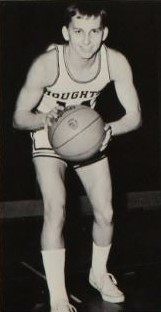 Houghton’s Lange scored his 60 as the Gremlins walloped Painsedale Jeffers, 134-62, on January 23, 1970. One week later, Larry Laitala dropped 65 as Champion crushed Felch, 114-71.
Houghton’s Lange scored his 60 as the Gremlins walloped Painsedale Jeffers, 134-62, on January 23, 1970. One week later, Larry Laitala dropped 65 as Champion crushed Felch, 114-71.
“We had a very good team that year. We had a lot of wings and normally, I wouldn’t play the whole game. My coach was Dominic Jacobetti (who played at Negaunee St. Paul, then Northern Michigan University) and he was a pretty prolific scorer in the U.P. It was one of those nights where the rim was real big,” recalled Laitala, chuckling.
Laitala finished second to Lange in regular-season scoring, 557 to 523, with each athlete playing 17 games.
“Houghton is possibly the best team in any class in the Upper Peninsula,” wrote Hal Schram in the Detroit Free Press, who predicted an MHSAA state title for the team noting that many felt Lange was the top player north of the bridge. The Gremlins, at 17-0, finished as the top-ranked team in Class C in the weekly press polls assembled by the Free Press, The Associated Press and United Press International.
But the season ended earlier than expected for both teams. Houghton fell to St. Ignace in a Regional Semifinal.
“We were beat by our archrival, Republic (61-55) in the first game of the (Class D) Districts, which was kind of an upset,” added Laitala.
Prior to Simonsen’s accomplishment, Lange and Laitala were the most recent players above the Straits of Mackinac to equal or exceed the 60-point minimum established in the MHSAA record book.
The Challenge of Traceability
With modern-day electronic archiving of a number of the state’s newspapers and the accessibility of newspapers on microfilm, an effort has been made to add dates to single-game records, where once only the season of accomplishment was listed. The work continues.
Today, more than 100 years later, the “two newspaper accounts” used back in the 1960s for verification of Burling’s scoring accomplishment have not resurfaced. Hence, neither the date of the game, nor details from period accounts are available for study. That, combined with knowledge that basketball games from the time were usually low-scoring affairs, means doubt is still cast on the mark.
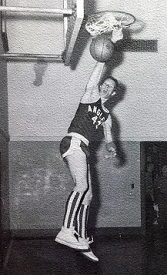 After investigation, the record was accepted by Crystal Falls historian Malcolm McNeil and U.P. sports archivist, Jim Trethewey, a former sports editor of the Marquette Mining Journal who travelled to Crystal Falls to interview Burling. MHSAA historian Dick Kishpaugh ultimately added the performance to the state record book. Questions about the legitimacy of Burling’s total began almost immediately and have resurfaced every 10 years or so. Todd Schulz, a former sports columnist at the Lansing State Journal, wrote extensively on the chase in 2012.
After investigation, the record was accepted by Crystal Falls historian Malcolm McNeil and U.P. sports archivist, Jim Trethewey, a former sports editor of the Marquette Mining Journal who travelled to Crystal Falls to interview Burling. MHSAA historian Dick Kishpaugh ultimately added the performance to the state record book. Questions about the legitimacy of Burling’s total began almost immediately and have resurfaced every 10 years or so. Todd Schulz, a former sports columnist at the Lansing State Journal, wrote extensively on the chase in 2012.
One of the individuals still working to help solve the mystery is Al Anderson of Crystal Falls.
The Diamond Drill was a weekly paper during Burling’s high school days, and newspapers of the time generally didn’t separate prep sporting news into sections. When reported upon, accounts of high school games were usually included in a ‘School Notes’ column.
The season was, without question, a success. “Winning eight out of ten games played, and having three challenges refused, the local basket ball team lay claim to the U.P. championship for the season of 1910-11,” stated the Diamond Drill in the March 25, 1911 edition.
Still, reports uncovered from the period publication continue to cast doubt on the plausibility of the feat occurring in a high school game. “… More basket ball and less indoor foot ball next time will look better to the audience,” noted the newspaper about a 17-10 victory over Niagara, Wis., in mid-December 1910.
“The basket ball game last night resulted in a dispute near the end of the last half with the score 13 to 12 in favor of Crystal Falls. Iron Mountain disputed a decision by the referee and withdrew from the floor,” was the account in the Feb. 18, 1911 edition of the paper.
“There’s an article that was cut out of the physical copy of the December 10, 1910 Diamond Drill,” reports Anderson, who’s been seeking confirmation in fits and starts for nearly a decade. “It looks like it could be the ‘School Notes.’ portion. It’s missing on microfiche copies as well. Perhaps that’s it.”
So the chase to verify continues.
2019-20 season brings sudden burst
Sophomore phenom Emoni Bates of Ypsilanti Lincoln is the latest prep player to etch his name in the MHSAA record book for scoring 63 points. He accomplished the feat in a 108-102 double-overtime win against Chelsea two weeks after Simonsen’s accomplishment. Statewide, that means 34 players have now scored 60 or more points in a game – 30 boys (10 in the U.P. and 20 in Lower Michigan) and four girls (one in the U.P and three in the Lower Peninsula).
Will the list be reduced by one? Time and additional research will tell.
 Ron Pesch has taken an active role in researching the history of MHSAA events since 1985 and began writing for MHSAA Finals programs in 1986, adding additional features and "flashbacks" in 1992. He inherited the title of MHSAA historian from the late Dick Kishpaugh following the 1993-94 school year, and resides in Muskegon. Contact him at [email protected] with ideas for historical articles.
Ron Pesch has taken an active role in researching the history of MHSAA events since 1985 and began writing for MHSAA Finals programs in 1986, adding additional features and "flashbacks" in 1992. He inherited the title of MHSAA historian from the late Dick Kishpaugh following the 1993-94 school year, and resides in Muskegon. Contact him at [email protected] with ideas for historical articles.
PHOTOS: (Top) Brad Simonsen celebrates becoming Houghton's all-time leading scorer Wednesday. (2) Stephenson's Mel Peterson. (3) Trout Creek's Jim Manning. (4) Houghton's Gary Lange. (5) Trout Creek's Bob Gale. (Top photo courtesy of Houghton Daily Mining Gazette. Peterson photo courtesy of Upper Peninsula Sports Hall of Fame. Houghton and Trout Creek photos courtesy of those schools' yearbook departments.)

